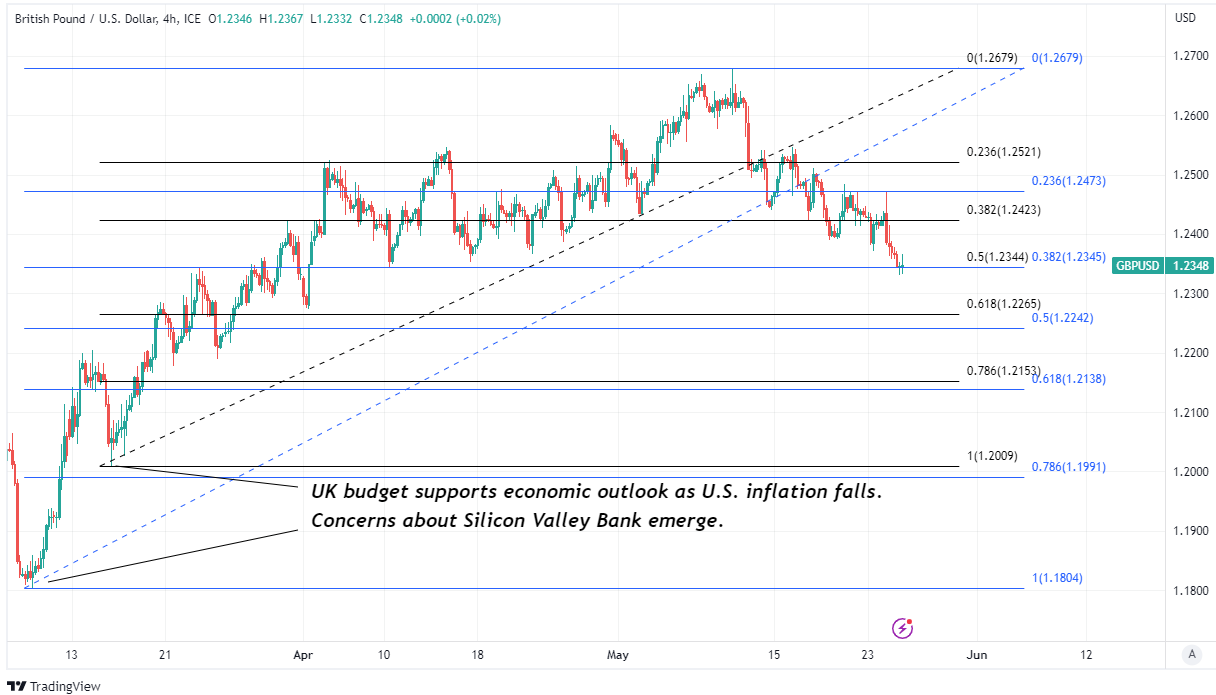GBP/USD Rate Tests Major Support On Charts but Is This a Bear Trap?
- Written by: James Skinner
-
"GBPUSD and nominal rate differentials remain good friends" - Spectra Markets.

Image © Adobe Images
The Pound to Dollar rate entered the penultimate session of the week testing major support on the charts but UK inflation and the bilateral interest rate outlook are just two reasons why recent losses could be a bear trap that begins to close on sellers of Sterling in the weeks or months ahead.
Dollars were bought broadly in Europe on Thursday amid widespread signs of risk aversion in financial markets entailing gains for government bond prices coming alongside declines for stock indices and some commodities.
Losses led the Pound to test a double-barreled layer of Fibonacci support near 1.2350 on the charts soon after Germany's statistics office revised an earlier estimate of first-quarter GDP growth to -0.3%, indicating a technical recession may be underway in Europe's largest economy.
Price action also followed minutes of the Fed's May meeting highlighting that rate-setters had sought to communicate a need for optionality in future interest rate decisions owing to uncertainty about the economic outlook.
"Participants emphasized the importance of communicating to the public the data-dependent approach of policymakers, and the vast majority of participants commented that the adjusted language in the post-meeting statement was helpful in that respect," the minutes said in part.

Policymakers raised the Fed Funds rate range to between 5% and 5.25% earlier this month and signaled uncertainty about the outlook for borrowing costs going forward though since that meeting some on the FOMC have suggested that June could see the benchmark left unchanged.
Governor of the Fed board Christopher Waller said on Wednesday that June's decision would be a choice between raising the Fed Funds rate to 5.5% or awaiting further information about the performance of the economy and the pace of decline in U.S. inflation.
"In my view, data since the last meeting of the Federal Open Market Committee (FOMC) has not provided sufficient clarity as to what we should do with our policy rate at the next meeting. We still have some major data releases coming up," he told the 2023 Santa Barbara County Economic Summit.
"I do not support stopping rate hikes unless we get clear evidence that inflation is moving down towards our 2 percent objective. But whether we should hike or skip at the June meeting will depend on how the data come in over the next three weeks," he added in a partial conclusion of the speech.
Interest rate futures suggested on Thursday that borrowing costs are likely to remain unchanged next month, which would be supportive of a UK-U.S. bond yield differential that currently suggests the Pound to Dollar rate should be trading up around the 1.27 handle.
Other macroeconomic factors including the trajectory of UK inflation also support the argument advanced by the UK-U.S. bond yield differential, with both suggesting the Pound to Dollar rate would be more appropriately priced up around the 1.27 level; where it traded only just recently.
"The market is trying to do the “high inflation in UK = stagflation = sell GBP” trade," says Brent Donnelly, president at Spectra Markets and a veteran currency trader with a career spent at a range of global banks including Nomura, HSBC, and Lehman Brothers.
"My view is that nominal yields are a simpler framework than trying to sell GBP on stagflation. Here is UK rate spreads vs. GBPUSD (above). Despite continuous concerns about stagflation… GBPUSD and nominal rate differentials remain good friends," he writes in Wednesday's am/FX letter.
Recent losses for Sterling followed Office for National Statistics figures out on Wednesday suggesting that UK inflation was slower in falling last month than many forecasters, including those at the Bank of England (BoE), had expected.
But inflation still fell by almost two percentage points from 10.1% to 8.7% and BoE forecasts indicated last week that it could fall further to around 7% by July, which is an uplifting influence for a real or fundamental 'fair value' that currently sits around 1.27 on some measures.
Above: Goldman Sachs Dynamic Equilibrium Exchange Rate model shows inflation-based fair value targets for various currencies. Source: Goldman Sachs Global Investment Research.
UK inflation has been a highly successful predictor of GBP/USD since at least 1995, according to research from Goldman Sachs, and currently indicates that Sterling might be likely to gravitate toward a 'fair value' of around 1.2798.
That would have implications for how the Pound trades against other currencies over the coming weeks or months, although the Goldman Sachs team warns against using these estimates as short-term trading signals.
"Putting it all together, inflation is an important input to fair value estimates, especially in the G10. But measurement issues can lead to a wide range in the ‘real’ exchange rate calculation. That is especially true right now," says Michael Cahill, a G10 FX strategist at Goldman Sachs.
"With few exceptions, these models tend to underperform a random walk at the very shortest horizons, which is consistent with our longstanding approach to use valuation as a long-term guide," he and colleague Sid Bhushan write in a Monday research briefing.
With the market response to Thursday's UK inflation figures aside, one other factor that could also be weighing on the Pound to Dollar rate is China's Renminbi, which has fallen relative to the Dollar in recent weeks.
Renminbi losses have accelerated since official figures suggested earlier this month that a recovery of the world's second-largest economy, from the effects of coronavirus-related closures, slowed in the second quarter. The global economy has lost momentum over this time.
"China is pointing to the USD rally as the primary cause for the recent CNY / CNH weakness, and they continue to indicate that their growth recovery is intact and will be the driver of strength in the CNY and CNH in the future," says Brad Bechtel, global head of FX at Jefferies.
Increases in the Dollar-Renminbi rate frequently weigh on other currencies to an even greater extent, which often leads the Renminbi to strengthen against those other third-party currencies, translating into an uplift in the overall or trade-weighted Renminbi.
"With concerns about Chinese growth persisting, commodity prices are still falling and Treasury yields rising, the only G10 currency which is up against the dollar this morning is sterling," writes Kit Juckes, chief FX strategist at Societe Generale, in a Thursday market commentary.
"And it’s not really doing much other than inflicting pain on people who bought EUR/GBP prematurely. UK action is in rates, where the market prices peak rates at 5 ½%, from where they would presumably have to be cut fast and furiously as the economy hit a brick wall," he adds.

